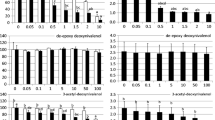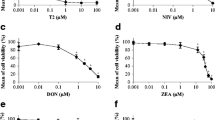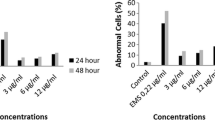Abstract
Lymphocytes cell obtained from healthy human donors and pigs were exposed to fumonisin B1 (FB1) and ochratoxin A (OTA), which have been found to be immunosuppressive, carcinogenic and mutagenic, to ascertain their single and combined cytotoxic effects with time and to assess the suitability of animal lymphocytes as test agents in comparison to human cells. The main objectives of this work were to assess the use of animal lymphocytes, particularly pig lymphocytes, for their use in the Methyl Thiazol Tetrazolium (MTT) cytotoxicity test, making them more accessible to animal research-based institutes in comparison to human lymphocytes previously used, and to study the cytotoxic and synergism or antagonistic effects of FB1 and OTA. The MTT assay, which measures cell viability and proliferation based on reduction of MTT to a blue dye, also used the addition of phytohaemagglutinin (PHA) to stimulate the blood cells. The results showed a progressive decrease in lymphocytes viability with time of exposure to the toxins. It was also noted that FB1, as compared to OTA, had a lower cytotoxicity on both human and pig lymphocytes cells. In addition, when the two mycotoxins were combined, a synergistic decrease of cell viability in both human and pig lymphocytes was observed, with pig lymphocytes showing a greater sensitivity. This study has shown that the MTT assay can be used for the determination of cytotoxicity of mycotoxins using animal, and in particular pig, lymphocytes, which eliminates the use of human donors and other cell cultures.
Similar content being viewed by others
References
Bezuidenhout SC, Gelderblom WCA, Gorst-Allman CP, Horak RM, Marasas WFO, Spiteller G, Vleggaar R (1988) Structure elucidation of the fumonisins, mycotoxins from Fusarium moniliforme. J Chem Soc Chem Commun (1988) 743–745
Cetin Y, Bullerman LB (2005) Cytotoxicity of Fusarium mycotoxins to mammalian cell cultures as determined by the MTT assay. Food Chem Toxicol 43:755–764
Charoenpornsook K, Fitzpatrick JL, Smith JE (1998) The effects of four mycotoxins on the mitogen stimulated proliferation of bovine peripheral blood mononuclear cells in vitro. Mycopathologia 143:105–111
Cook WO, Osweiler GD, Anderson TD, Richard JL (1986) Ochratoxicosis in Iowa swine. Am Vet Med Assn 188:399–1402
Creppy EE (1995) Ochratoxin A in food: molecular basis of its chronic effects and issues involving toxic microorganism. Alaken, Fort Collins, pp 445–450
Creppy EE, Stormer FC, Roschenthaler R, Dirheimer G (1983) Effects of two metabolites of ochratoxin A, (4R)-4-hydroxyochratoxin A and ochratoxin alpha, on immune response in mice. Inf Immun 39:1015–1018
Creppy EE, Chiarappa P, Baudrimont I, Borracci P, Moukha S, Carratu MR (2004) Synergistic effects of fumonisin B1 and ochratoxin A: are in vitro cytotoxicity data predictive of an in vivo acute toxicity? Toxicology 201:115–123
Dombrink-Kurtzman MA, Javed T, Bennett GA, Richard JL, Cote LM, Buck WB (1993) Lymphocyte cytotoxicity and erythrocytic abnormalities induced in broiler chicks by fumonisins B1 and B2 and moniliformin from Fusarium proliferatum. Mycopathologia 124:47–54
Dombrink-Kurtzman MA, Bennett GA, Richard JL (1994) An optimized MTT bioassay for determination of cytotoxicity of fumonisins in turkey lymphocytes. J Assoc Off Anal Chem Int 77:512–516
Dutton MF (2009) The African Fusarium/maize disease. Mycotox Res 25:29–39
Fazekas B, Bajmócy E, Glávits R, Fenyvesi A (1997) Fumonisin mycotoxicoses in Hungary. Leukoencephalomalacia in horses, fattening pulmonary oedema in pigs. Hung.Vet J 119:137–139 (in Hungarian)
Gräbsch C, Wichmann G, Loffhagen N, Herbarth O, Müller A (2006) Cytotoxicity assessment of gliotoxin and penicillic acid in Tetrahymena pyriformis. Environ Toxicol 21:111–7
Gelderblom WCA, Jaskiewicz K, Marasas WFO, Thiel PG, Horak RM, Vleggaar R, Kriek NP (1988) Fumonisins- novel mycotoxins with cancer promoting activity produced by Fusarium moniliform. Appl Environ Microbiol 54:1806–1811
Hanelt M, Gareis M, Kollarczik B (1994) Cytotoxicity of mycotoxins evaluated by the MTT-cell culture assay. Mycopathologia 128:167–174
Huff WE, Kubena LF, Harvey RB, Doerr JA (1988) Mycotoxin interaction in poultry and swine. J Anim Sci 66:2351–2355
Huang C, Dieckeman M, Henderson G, Jones C (1995) Repression of protein kinase C and stimulation of cyclic AMP response elements by fumonisins, a fungal encoded toxin which is carcinogen. Cancer Res 55:1655–1659
Hussein SH, Brasel MJ (2001) Toxicity, metabolism, and impact of mycotoxins on humans and animals. Toxicology 67:101–134
Jenkins GR, Tolleson WH, Newkirk DK, Robert DW, Rowland KL, Seheki T, Koyabashi K, Howard PC, Melchior WB (2000) Identification of fumonisin B1 as an inhibitor of argininosuccinate synthetase using fumonisin affinity chromatography and in vitro kinetic studies. J Biochem Mol Toxicol 14:320–328
Jones C, Ciacci-Zanella JR, Zhang Y, Henderson G, Dickman M (2001) Analysis of fumonisin B1 induced apoptosis. Environ Health Perspect 109(Suppl 2):315–320
Kouadio JH, Mobio TA, Baudrimont I, Moukha S, Dano SD, Creppy E (2005) Comparative study of cytotoxicity and oxidative stress induced by deoxynivalenol, zearalenone or fumonisin B1 in human intestinal cell line Caco-2. Toxicology 213:56–65
Kovács F, Sándor G, Ványi A, Domány S, Zomborszky-Kovács M (1995) Detection of ochratoxin A in human blood and colostrum. Acta Veterinaria Hungarica 43:393–400
Lewis CW, Smith JE, Anderson JG, Freshney RI (1999) Increased cytotoxicity of food-borne mycotoxins toward human cell lines “in vitro” via enhanced cytochrome p450 expression using the MTT bioassay. Mycopathologia 148:97–102
Lioi MB, Santoro A, Barbieri R, Salzano S, Ursini MV (2004) Ochratoxin A and zearalenone: a comparative study on genotoxic effects and cell death induced in bovine lymphocytes. Mut Res 557:19–27
Lautraite S, Parent-Massin D, Rio B, Hoellinger H (1995) Comparison of toxicity induced by T-2 toxin on human and rat granulo-monocytic progenitors with an in vitro model. Hum Experiment Toxicol 14:672–678
Marquardt RR, Frolich AA (1992) A review of recent advances in understanding ochratoxicosis. J Anim Sci 70:3968–3988
Meisner H, Chan S (1974) Ochratoxin A, an inhibitor of mitochondrial electron transport systems. Biochemist 13:2795–2800
Meky FA, Hardie LJ, Evans SW, Wild CP (2001) Deoxynivalenol-induced immunomodulation of human lymphocyte proliferation and cytokine production. Food Chem Toxicol 39:827–836
Maenetje WM, de Villiers N, Dutton MF (2008) The use of isolated lymphocytes in mycotoxin cytotoxicity testing. Int J Mol Sci 9:1515–1526
Marasas WFO, Shephard GS, Sydenham EW, Thiel PG (1993) World-wide contamination of maize with fumonisins: foodborne carcinogens produced by Fusarium moniliforme. Proc ICC International Congress Pretoria, 791–805
Mobio TA, Anane R, Baudrimont I, Carratu M-R, Shier TW, Dano SD, Ueno Y, Creppy EE (2000) Epigenetic properties of fumonisin B1: cell cycle arrest and DNA base modification in C6 glioma cells. Toxicol Appl Pharmacol 164:91–96
Park JW, Kim EK, Shon DH, Kim YB (2002) Natural co-occurrence of aflatoxin B1 fumonisin B1 and ochratoxin A in barley and corn foods from Korea. Food Add Contam 19:1073–1080
Pohland AES, Nesheim S, Friedman L (1992) Ochratoxin A, a review. Pure Appl Chem 64:029–1046
Preissler V, Caspary WJ, Hoppe F, Hagen R, Stopper H (2000) Aflatoxin B1-induced mitotic recombination in mouse lymphocyte cells. Mutagenesis 15:91–97
Rafai P, Bata R, Jakab L, Vanyi A (2000) Evaluation of mycotoxin-contaminated cereals for their use in animal feeds in Hungary. Food Add Contam Part A 17:799–808
Ramljak D, Calvert RJ, Wiensenfeld PW, Diwan BA, Catipovic B, Marasas WFO, Victor TC, Anderson LM, Gelderblom WC (2000) A potential mechanism for fumonisin B (1)-mediated hepatocarcinogenesis: cyclin D1 stabilization associated with activation of Akt and inhibition of GSK-3beta activity. Carcinogen 21:1537–1546
Schroeder JJ, Crane HM, Xia J, Liotta DC, Merrill AH (1994) Disruption of sphingolipid metabolism and stimulation of DNA synthesis by fumonisin B1. A molecular mechanism for carcinogenesis associated with Fusarium moniliforme. J Biol Chem 269:3475–3481
Voss KA (1990) Toxins from Fusarium moniliforme, a common fungus in corn. Vet Hum Toxicol 32:57 (Suppl)
Wang E, Norred WP, Bacon CW, Riley RT, Merrill A (1991) Inhibition of sphingolipid biosynthesis by fumonisins. Implications for diseases associated with Fusarium moniliforme. J Biol Chem 266:14486–14490
Wei YH, Lu CY, Lin Wei RD (1985) Effects of ochratoxin A on rat liver mitochondrial respiration and oxidative phosphorylation. Toxicology 36:119–130
Wikipedia (2009) http://en.wikipedia.org/wiki/ accessed March 2009
Acknowledgements
Authors would like to thank the Hungarian Academy of Sciences (Office for Subsidised Research Units), the TéT Foundation (Project No.: ZA-28/2006), and South African National Research Foundation for supporting this study.
Author information
Authors and Affiliations
Corresponding author
Rights and permissions
About this article
Cite this article
Mwanza, M., Kametler, L., Bonai, A. et al. The cytotoxic effect of fumonisin B1 and ochratoxin A on human and pig lymphocytes using the Methyl Thiazol Tetrazolium (MTT) assay. Mycotox Res 25, 233–238 (2009). https://doi.org/10.1007/s12550-009-0033-z
Received:
Accepted:
Published:
Issue Date:
DOI: https://doi.org/10.1007/s12550-009-0033-z




